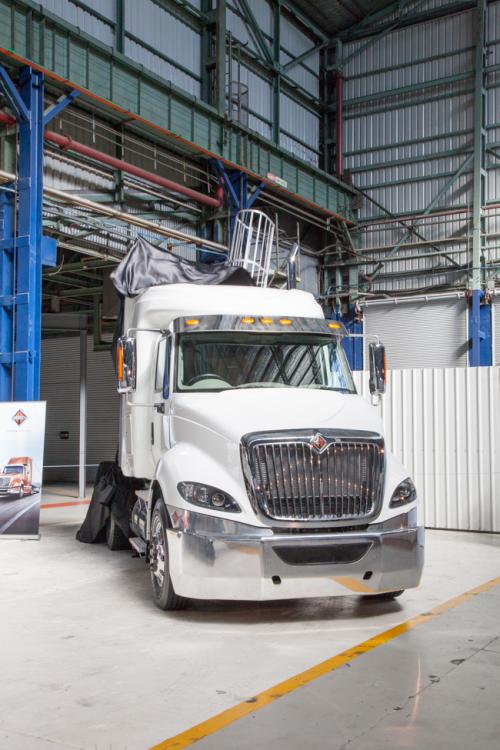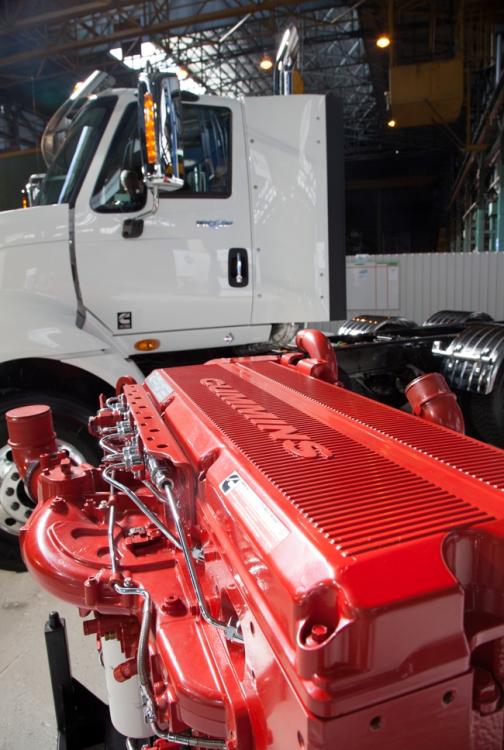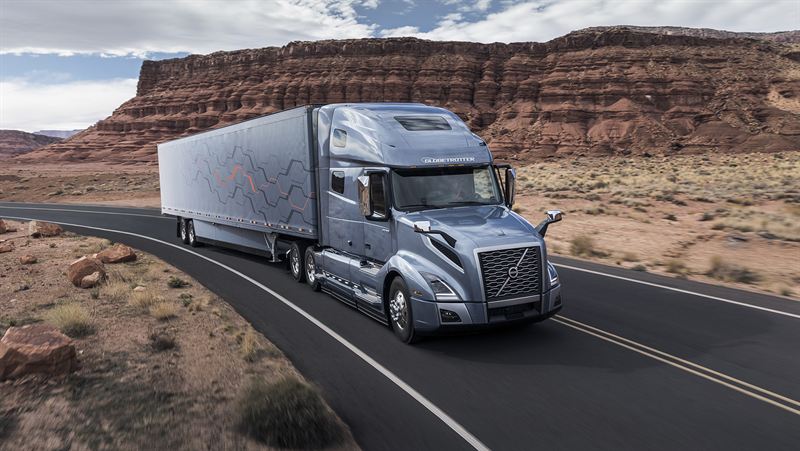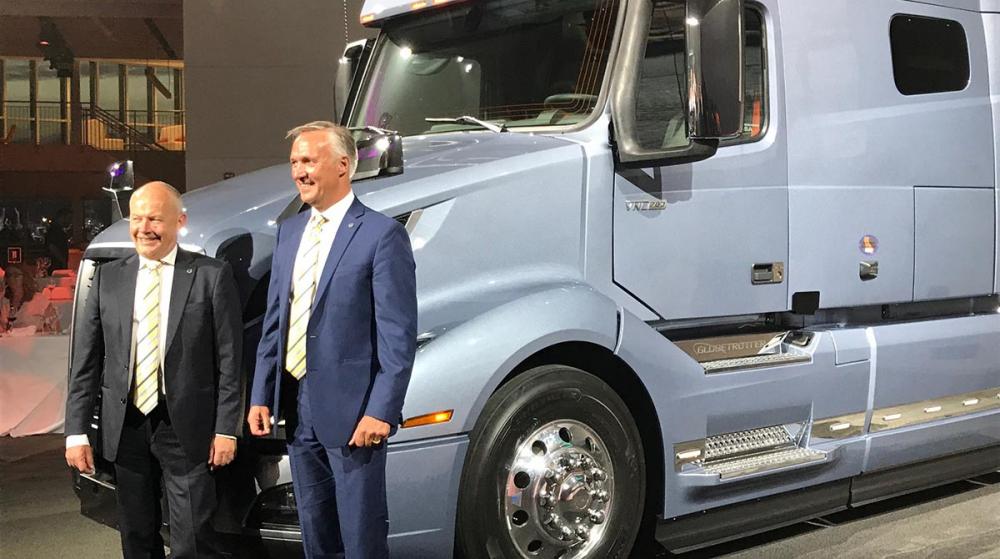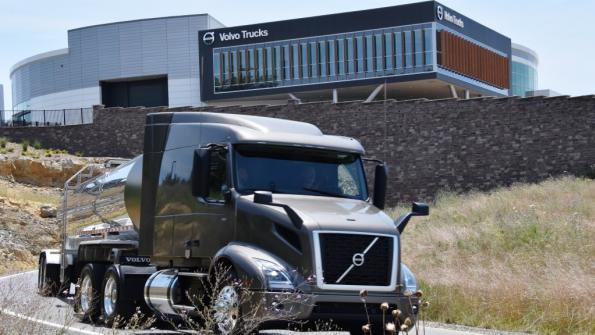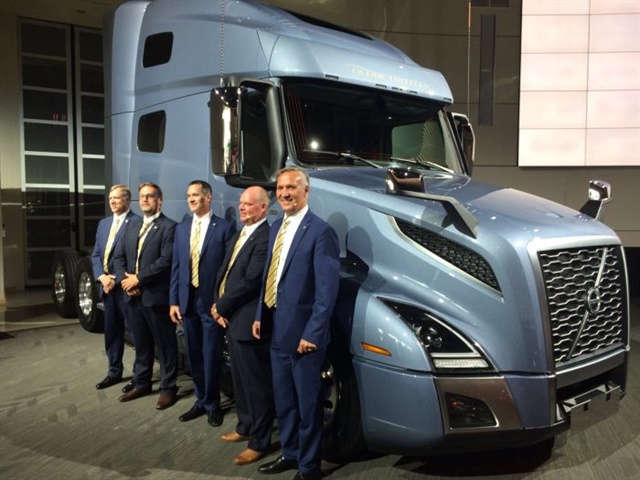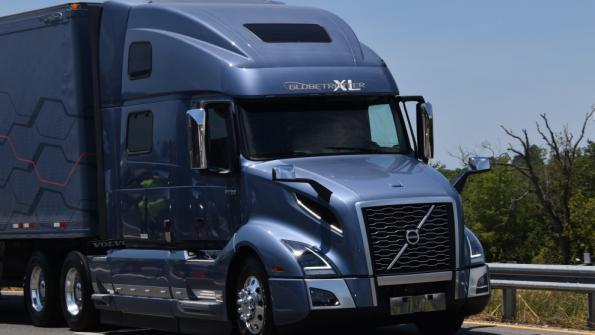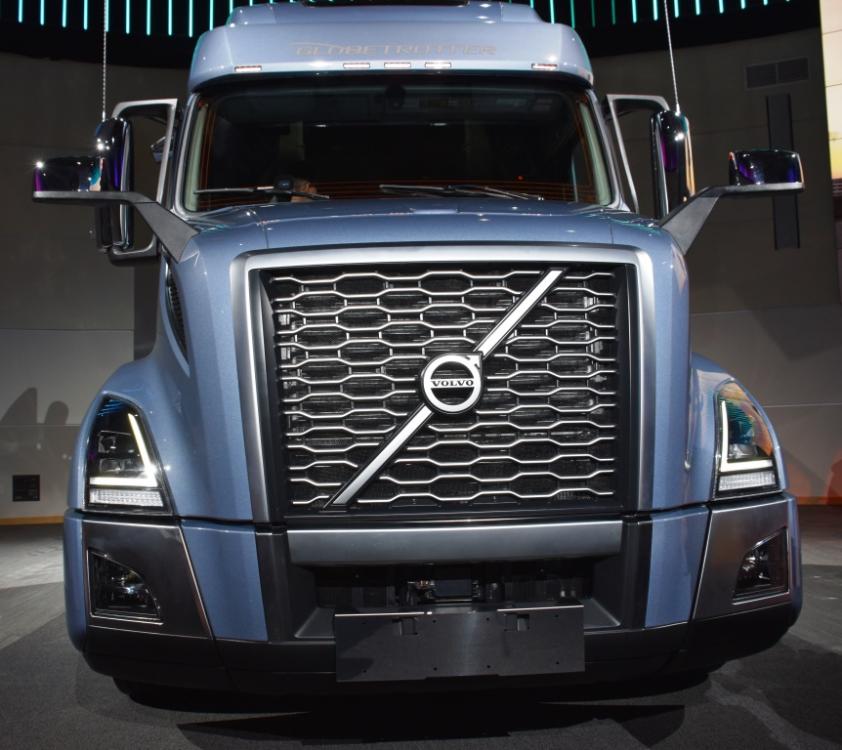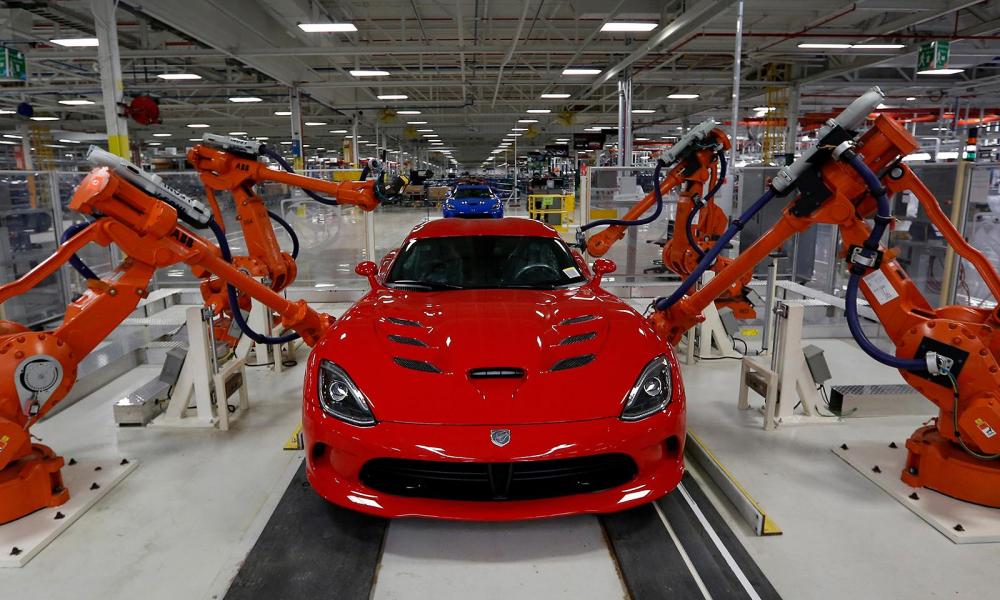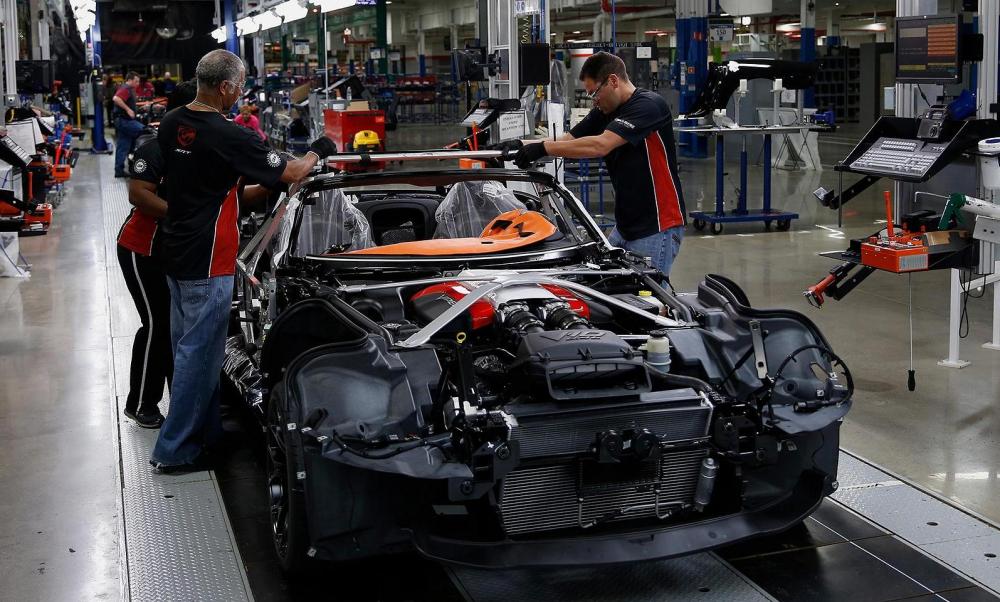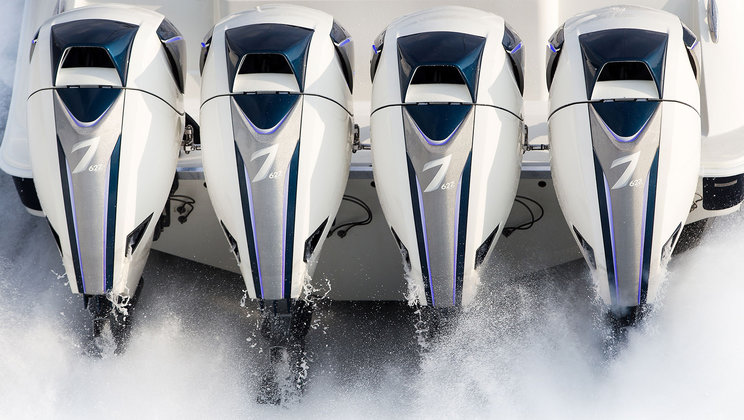
kscarbel2
Moderator-
Posts
18,869 -
Joined
-
Days Won
114
Content Type
Profiles
Forums
Gallery
Events
Blogs
BMT Wiki
Collections
Store
Everything posted by kscarbel2
-
Iveco reveals International dealer network Prime Mover Magazine / July 13, 2017 Iveco Australia has revealed the first group of dealerships that will oversee the sales, service and parts support for the newly launched International ProStar truck range in Australia. Initial appointments are all Iveco dealers and authorised Cummins service outlets, including Sydney Iveco, Thomas Bros and Blacklock’s in New South Wales, Brisbane Iveco and Wideland Trucks and Equipment Group in Queensland, Adelaide Iveco in South Australia, Smith Trucks in Victoria, and AV Truck Services in Perth, Western Australia. According to Iveco, further retail outlets will be appointed in all states of Australia along with Parts and Service-only branches, to provide a broader support network for the International brand. Iveco Australia Dealer Channel Director, Geoff Buswell, said the company was selective in its appointments to ensure all accredited dealers were qualified to service and support the International brand. “In re-launching the iconic International brand back into the Australian market, we have been fortunate to have access to our existing Iveco network across Australia,” Buswell said. “Many of the new dealerships have had a long history with International, having previously sold and serviced the range when it was last available in Australia. In fact many Dealers still offer support for previous generation International products. “Another benefit of appointing existing Iveco dealers is that they already have a thorough knowledge and understanding of much of the ProStar’s componentry by virtue of several existing Iveco models featuring Cummins, Hendrickson, Eaton and Meritor equipment. “We are extremely pleased with our initial appointments and we are in the process of adding to these Dealers in the coming days and weeks. We will provide a complete dealer network as representation for all prospective ProStar buyers in metropolitan and rural areas.”
-
New Models From International Australia Diesel News AU / July 2017 This year will see the introduction of a number of new models from International. There are four basic models in the new ProStar range arriving on the Australian truck market – a day-cab prime mover, a day-cab tipper chassis, an extended cab sleeper and a 40-inch sleeper-cab prime mover option. All of these will have just one engine option – the Cummins X15, the renamed evolution of the highly successful E5 ISX. It will be rated at 550hp (410kW) and put out 2,580Nm (1850 ft lb) of torque. This is probably the most popular engine and rating in the Australian heavy-duty market. So no surprises there. As you look down the specification list, the names that come up are all very familiar – this is a range aimed at the heart of the Aussie truck market. Hendrickson Primaax rear suspension, Meritors, front and rear, Roadranger or Ultrashift, Sheppard steering, Horton fan and many more would all appear on the favoured option list for most of the North American brands in Australia. Choosing the Ultrashift Plus option on the gearbox will introduce the opportunity to utilise the ADEPT system, a cooperative electronic linking of Eaton transmission and Cummins engine to maximise performance and minimise fuel use, which is proving a popular fuel-saving choice for a number of operators. Inside the cabin will be familiar to anyone who has spent any time looking around the Cat models on offer. However, there have been some improvements on the interior layout integrated into the new ProStar. One is the improved space for the driver’s left foot, often an issue for US-made trucks. The engine cover has been reshaped and the left foot has a resting pad just to the left of the clutch. These two global players have given themselves a chance with these new models. Navistar seeks to gain from opening up another truck market for its plant at Escobedo in Monterrey, Mexico at the same time as, if Trump has his way, importing into the US from south of the border may become less attractive. For Iveco in Australia, this is a chance for the company and its dealer network to get themselves back on track as a serious player in the truck market. The ongoing success of the Acco has papered over a few cracks in the Iveco organisation. The introduction of a real North American truck into the mix may give Iveco a chance to consolidate and not be quite so reliant on one ageing vocational model. The $64,000 question is whether the truck buyers of Australia will take to this newcomer. The strength of the International brand is not to be underestimated. The trucking industry has a long memory and a lot of people made a lot of money running Inters in the past, and may well want to do so in the future. The true test will be when there are bums in seats where the driving experience and overall performance can be assessed in a real world setting. Look out for a drive test report in an upcoming Diesel Magazine. .
-
SILK WAY RALLY 2017: IVECO in the top five of the 6th leg with Kazakh pilot Artur Ardavichus IVECO Trucks Press Release / July 14, 2017 Artur Ardavichus crossed the finish line of the 6th stage, from Semey to Urdzhar, in 5th position with his IVECO Powerstar. He is well-motivated to remain in the top five of the overall ranking of the Silk Way Rally. Gerard De Rooy and Ton Van Genugten finished the stage in 8th and 11th position respectively. The newest member of Team PETRONAS De Rooy IVECO, Kazakh driver Artur Ardavichus was the protagonist of yesterday’s stage, which took the competitors from Semey to Urdzhar: 387 km of an amazing and fast track made of 60% soil and 40% gravel. Starting at 9.40h behind teammates Gerard De Rooy and Ton Van Genugten, Artur Ardavichus, Serge Bruynkens and Michel Huisman, placed their IVECO Powerstar #310 truck in the fifth position in the day’s classification, crossing the line 5m55s behind the first. With this result, at the close of Stage 6 the Kazakh pilot was fifth in the partial general classification. His steady driving is bringing excellent results to Team PETRONAS De Rooy IVECO. Team leader De Rooy placed his renovated IVECO Powerstar in 8th position, finishing the race in 4h04m47s – 26m09s behind the first. Crossing the line 58m46s behind the winner, Van Genugten, placed his #306 Trakker Evolution in eleventh position, improving his final ranking to 9th. Today, July 14th, competitors will run the fourth and last special in Kazakhstan before crossing the Chinese border. This magnificent 106km SS will be pure driving pleasure. The vegetation will be dense and the landscape hilly. The finish of the stage “In the land of black gold” will be close to the border, before a 250 km liason to the bivouac in Karamay, famous for its oil refineries. Stage 6 results – Silk Way Rally 2017 1. Eduard Nikolaev (Kamaz) 3h38m38s 2. Martin Kolomy (Tatra) +0m39s 3. Dmitry Sotnikov (Kamaz) +5m13s 4. Airat Mardeev (Kamaz) +5m51s 5. Artur Ardavichus (IVECO) +5m55s ------ 8. Gerard De Rooy (IVECO) +26m09s 11. Ton Van Genugten (IVECO) 58m46s Overall classification – Silk Way Rally 2017 1. Dmitry Sotnikov (Kamaz) 19h09m17s 2. Anton Shibalov (Kamaz) +2m12s 3. Martin Kolomy (Tatra) +12m53s 4. Airat Mardeev (Kamaz) +24m01s 5. Artur Ardavichus (IVECO) +56m45s ----- 9. Ton Van Genugten (IVECO) +5h05m25s 15. Gerard De Rooy (IVECO) +108h07m35s Starting order for SS7 – 14th July 2017 07.35 Eduard Nikolaev (Kamaz) 07.37 Martin Kolomy (Tatra) ---- 07.47 Artur Ardavichus (IVECO) 08.06 Gerard De Rooy (IVECO) 08.11 Ton Van Genugten (IVECO) .
-
.
-
MAN Truck & Bus Press Release / July 13, 2017 .
-
Volvo Unveils Next-Generation VNL Highway Tractor
kscarbel2 replied to kscarbel2's topic in Trucking News
Volvo Trucks unveils new VNL series Volvo Group Press Release / July 12, 2017 Volvo Trucks North America reveal the new Volvo VNL series, a groundbreaking tractor that meets the needs of today’s long-haul trucking customers and professional drivers through cutting-edge innovations in efficiency, productivity, safety and uptime. Available in several configurations, including an all-new, 70-inch sleeper, the Volvo VNL series defines the shape of trucks to come. “The new Volvo VNL builds on our long-standing commitment to deliver the safest, most comfortable and most efficient long-haul truck on the market,” says Göran Nyberg, president of Volvo Trucks North America. “Infused with new innovations and technologies, we’re proud to expand upon that commitment to our current and future customers with this new design.” Designers of the new Volvo VNL combined elements of Volvo’s design language with dynamic new features. Swept back headlights include signature Volvo daytime running lights and frame a bold new Volvo grille and hood. Redesigned and repositioned engine air intakes allow for less turbulent intake air delivery. Airflow up and around the cab has also been optimized with new chassis and roof fairings. “While we wanted the new VNL to make a statement on the road, we knew that it also had to make a statement to our customers’ bottom lines” says Wade Long, director of product marketing for Volvo Trucks North America. “The incredible design elements that we’ve incorporated not only look great, but they add value for the customer. The VNL series comes standard with the 13-liter Volvo D13 engine, while Daycab and VNL 400 models can spec the 11-liter Volvo D11 as an option. The 15-liter Cummins X15 is also available in the VNL series. The new Volvo VNL series was designed and engineered at Volvo Trucks’ North American technology center in Greensboro, North Carolina, and will be built at Volvo’s New RiverValley assembly plant in Dublin, Virginia, where all Volvo models for the U.S. are assembled. Volvo engines and transmissions powering each VNL model will be produced at Volvo’s powertrain manufacturing facility in Hagerstown, Maryland. . -
Volvo Unveils Next-Generation VNL Highway Tractor
kscarbel2 replied to kscarbel2's topic in Trucking News
-
Detroit Press Release / July 12, 2017 . . . . . . .
-
Volvo Issues Upbeat Truck Forecast Heading into Fall
kscarbel2 replied to kscarbel2's topic in Trucking News
Volvo Leaders Optimistic About Truck Market Transport Topics / July 13, 2017 DUBLIN, Va. — The leaders of Volvo Trucks’ global and North American operations expressed optimism about the second half of this year and into 2018 during presentations for the launch of the company’s new VNL longhaul tractor. “We believe this market has bottomed out, and we see upward pressure,” Volvo Trucks Global President Claes Nilsson, said about the North American market. Goran Nyberg, president of Volvo Trucks North America, added that a rebounding manufacturing sector will help lift sales going forward, though he acknowledged that the company is struggling with a high inventory-to-sales ratio. “We believe that second half of 2017 will be stronger and expect that to carry into 2018,” he said. VTNA is based in Greensboro, N.C., and the global operation is based in Gothenburg, Sweden. Nilsson said that while 2017 is the third consecutive year of declining volumes overall, orders through April for the new VNR regional haul tractor are already outpacing full-year 2016 orders for the VNM model it replaces. He said that the United States is by far the manufacturer’s largest market; other key markets include Germany, the United Kingdom, France and Brazil. Nyberg said that the shifting scope of retail dynamics is providing a lift to the North American regional-haul market. “There is more e-commerce and next-day delivery to customers as opposed to stores,” he said. He also said that strength in the construction industry is helping the regional-haul sector. “It is a good time to be in the construction business,” Nyberg said. Not so for natural gas-powered trucks, however, he said. “Natural gas, it is no surprise, is going sideways, and we expect it to continue to go sideways due to the prices for diesel,” he said. The U.S. retail price of diesel, trucking’s main fuel, has been below $2.60 a gallon throughout 2017, the Department of Energy’s Energy Information Administration said. Diesel last cleared $3 a gallon Jan. 12, 2015, when it was $3.053 a gallon. Nilsson said the company’s service and aftermarket businesses have “grown very successfully over the last few years” thanks to the growth of Volvo’s captive engines and transmissions. “That is a much healthier business than it was a few years ago,” he said. Volvo’s dealer network also is healthier, according to Nyberg, who said since 2010 North American dealers have invested more than $600 million in their stores. VTNA dealers now number 420 “and counting,” he said, including 65 that have opened since 2010. “We are investing, and our dealers are also investing,” he said. “We have a very strong business and are very optimistic about the future.” . -
A 280 ton truck stopped for operating without a permit in RI
kscarbel2 replied to Jamaican Bulldog's topic in Trucking News
Grounded 280-ton truck finally allowed to move, carrier forced to pay state $60k Overdrive / July 13, 2017 The 280-ton truck that was grounded on the side of I-95 in Rhode Island two weeks ago for lack of a proper permit was finally able to head to its destination in Massachusetts this week, albeit at a hefty price. According to Rhode Island TV station turnto10.com, the company hauling the 560,000-pound generator, Bay Crane Northeast, agreed to take out a $25 million insurance policy, with the state as a co-insured party, as well as pay the cost of the police escort through the state. It also had to reimburse Rhode Island DOT $60,000 for its trouble in dealing with the truck. “Public safety has always been our priority in this matter,” RIDOT Director Peter Alviti told the news station. “It was our job to make sure that the people of Rhode Island were kept safe and that our roads and bridges were not damaged. We have achieved this. This accord also protects the financial interests of the taxpayers of the state with Bay Crane’s agreement to reimburse the state for expenses brought about by the unique nature of this situation.” Before the truck began its original journey, Bay Crane had applied for an overweight permit, but started the trip before the permit was granted. The company said at the time it expected the permit to come through before it became a problem. Video - http://turnto10.com/news/local/ridot-stuck-truck-to-be-moved-monday-night -
Fleet Owner / July 12, 2017 DUBLIN, VA.Volvo Trucks North America on Tuesday celebrated the opening of its VolvoTrucksCustomerExperienceCenter at its New River Valley (NRV) facility here. Built to showcase Volvo products, innovations and the brand in a dynamic way to engage visitors, the VolvoTrucksCustomerExperienceCenter was part of a $38.1 million investment in the facility where all Volvo truck models for North America are assembled. “We are very pleased to open the VolvoTrucksCustomerExperienceCenter, which we believe will serve as a destination for all of our North American customers and other visitors,” said Göran Nyberg, president of Volvo Trucks North America. “Now, our trucks, engines and transmissions are all spotlighted in one location, in a one-of-a-kind facility designed to offer a unique brand experience that only Volvo can offer.” Officials broke ground on the 36,000 square-foot custom-designed facility in September 2015. The facility includes a product showroom, two exhibit rooms, two pilot review rooms and a theater-in-the-round at the center of the building seating 290. The theater-in-the-round revolves and has an 82-foot turntable. An observation area allows customers to view the trucks traveling around the 1.1-mile Customer Experience Track, where banked corners enable highway speeds and numerous surfaces and grades permit drivers to experience difficult road conditions in a designated off-highway area. “This has been an historic day for Volvo Trucks North America,” Nyberg said. “First, we launched our innovative and sleek new Volvo VNL, and we opened this new facility. We look forward to an exciting future for Volvo Trucks in North America and in Dublin.” The building design is shaped like the Volvo Trucks iron mark and was developed with unique Volvo detailing in mind, following a Scandinavian timeless design. The purpose of the facility is to provide customers, dealers and visitors a uniquely Volvo experience. In addition to the CustomerExperienceCenter, the $38.1 million investment funded several plant upgrades to further improve the safety, quality and efficiency of NRV’s manufacturing processes. “This new facility recognizes the tremendous contribution that NRV employees deliver to the trucking industry and our customers,” said Franky Marchand, vice president and general manager at the plant. .
-
Jack Roberts, Heavy Duty Trucking / July 13, 2017 By day’s end, with the new VNL launch behind them and the cocktail reception kicking off, the mood among Volvo Trucks North America executives was positively jubilant. The press debut of the new tractor had gone off without a hitch. And even more exciting, from the executives’ point of view, order books for the new truck had opened earlier in the day to enthusiastic responses from Volvo customers. And while he declined to give specifics, one Volvo official described the response from North American fleets and dealerships as “phenomenal.” It was a fitting cap to an upbeat day, which included an optimistic update on the state of the North American truck market for the year to date by Claes Nilsson, president of Volvo’s global truck operations. Because Volvo is one of the largest truck and engine manufacturers in the world today, Nilsson naturally began by looking at global market conditions, citing the company’s current 17% market share in Europe while noting that Volvo is now the “leading” truck OEM in Russia, with 23% share in that market. The United States remains the largest truck market in the world, he added, with Germany in second place. South American markets are generally strong, Nilsson said, although demand in Brazil is currently weak. Core markets in Asia and Africa, including South Korea, Japan, and South Africa are also strong – although Nilsson said demand in oil-producing countries is flat. In North America, Nilsson said Volvo feels the market has flattened out and is looking for upward sales pressure moving into the second half of 2017 – a trend he is confident the new VNL tractor will be able to capitalize on. Volvo’s North America President Göran Nyberg built upon Nilsson’s comments, noting that a strong labor market in the U.S. and a boost in consumer spending is driving Gross Domestic Product growth, which he said points to a rebounding marketing sector as the year closes out and should lead to moderate growth in that sector in 2018. Other positive trends cited by Nyberg include low diesel prices as well as a domestic construction market currently at an all-time high level and poised for continued, gradual increases in volumes. Breaking North American trucking market segments down, Nyberg said Volvo sees increased equipment demands in long haul, regional haul, and construction, while demand for natural gas-powered trucks is holding steady at last year’s volumes. All told, Nyberg said he predicts a “fairly strong” Class 8 market in North America of around 215,000 units for 2017. Looking at the state of Volvo’s North American operations, Nyberg said that to date, 93% of new Volvo trucks have been spec’d with Volvo engines, while 91% of those trucks rolled off the factory floor fitted with an I-Shift automated manual transmission. Moreover, Volvo now has more than 120,000 “connected” trucks on the road capable of remote programming to update powertrains and after-treatment systems. Volvo now has 420 dealerships in North America, Nyberg added, and the company has invested more than $600 million in those facilities and personnel since 2010. This figure includes a recent investment of more than $38 million, which includes the new Customer Experience Center in New River, VA, as well as enhancements to the company’s manufacturing facility there. .
-
Volvo Unveils Next-Generation VNL Highway Tractor
kscarbel2 replied to kscarbel2's topic in Trucking News
New Volvo VNL focuses on driver, safety, efficiency Kevin Jones, Fleet Owner / July 12, 2017 DUBLIN, VA. With the first substantial redesign in 20 years, Volvo Trucks North America on Tuesday revealed the new Volvo VNL series of long-haul tractors. In presentations at the brand new VolvoTrucksCustomerCenter here, company representatives touted the new VNL’s cutting-edge innovations in efficiency, productivity, safety and uptime. Led by an all-new, 70-inch sleeper, the Volvo VNL series defines “the shape of trucks to come”—the theme of the launch. “The new Volvo VNL builds on our long-standing commitment to deliver the safest, most comfortable and most efficient long-haul truck on the market,” said Göran Nyberg, president of Volvo Trucks North America. “Infused with new innovations and technologies, we’re proud to expand upon that commitment to our current and future customers with this new design.” And while exterior design is striking, many of the new truck’s innovations target the needs of the driver, explained Jason Spence, product marketing manager – long haul. “The driver is the focal point of this vehicle. A comfortable driver is a productive driver,” said Spence. “Even when we launched the VNL, starting in 1996 and with the update in 2002, it was ahead of its time. The new VNL is another leap that’s ahead of its time.” 'Making a statement' Designers of the new Volvo VNL combined elements of Volvo’s design language with dynamic new features. Swept back headlights include signature Volvo daytime running lights and frame a bold new Volvo grille and hood. Redesigned and repositioned engine air intakes allow for less turbulent intake air delivery. Airflow up and around the cab has also been optimized with new chassis and roof fairings. “While we wanted the new VNL to make a statement on the road, we knew that it also had to make a statement to our customers’ bottom lines” said Wade Long, director of product marketing for Volvo Trucks North America. “The incredible design elements that we’ve incorporated not only look great, but they add value for the customer. Whether it’s the sleek new bodywork that improves aerodynamics, or the new three-piece bumper that aids in repairability, every design change we’ve made has a purpose.” Behind the wheel The new Volvo VNL features an all-new dashboard which puts often-used controls within the driver’s reach. Centered in the gauge cluster is a configurable, five-inch color driver information display that provides trip and diagnostic data. The driver information display is customizable, ensuring that critical information is always available to the driver at a quick glance. An optional infotainment system is available, featuring a seven-inch color touchscreen, navigation and an exterior back-up camera. A premium audio system is integrated with the infotainment system, which also features Bluetooth and Apple CarPlay for the ultimate in connectivity. Additional apps can be downloaded to the infotainment system as well. A dash-top tray features 12-volt power and USB connectivity to keep devices fully powered. The new Volvo VNL is also equipped with Volvo’s smart steering wheel, putting controls for nearly all of the driver interface functions right at a driver’s fingertips. The smart steering wheel is attached to Volvo’s Perfect Position air-assisted, infinitely adjustable steering column, which enables drivers not only to tilt and telescope the steering column, but also tilt the steering wheel relative to the steering column. This lets drivers of all statures find the perfect steering wheel position and easily view the driver information display. A wide variety of seating options are available on the new Volvo VNL series. Premium features like seat heating and ventilation are also available. “We relied on feedback from nearly 2,000 driver interviews to make sure the changes we were making aligned with drivers’ needs,” said Spence. “The results speak for themselves: our new VNL features the most comfortable, driver-friendly environment we’ve ever built.” Living environments That comfort extends to the four sleeper cab configurations available in the new Volvo VNL series. Designed to provide drivers a comfortable place to rest after a long day on the road, the sleeper options are packed with a number of space-saving, comfort-boosting innovations. Additionally, an all-new, full 70-inch sleeper is available in the Volvo VNL 760 and 740 models, taking comfort to an all-time high. All VNL sleepers feature curved cabinets that open toward the back to maximize space, as well as an integrated, reclining bunk, which is a trucking industry first in North America. LED interior lighting reduces power consumption and provides softer lighting. A redesigned sleeper control panel allows drivers to control heating and cooling, and adjust the audio system from a more ergonomic position on the bunk. In addition, drivers can lock the doors or activate a panic alarm if needed. For the first time in North America, Volvo’s Globetrotter trim levels will be available on the VNL 760 and VNL 860 sleeper models. Long a symbol of ultimate driver comfort, the Globetrotter trim levels include a full aerodynamic package, polished wheels, high-end seating, as well as a refrigerator, inverter and parking cooler package. 7.5% more fuel efficient The VNL series comes standard with the 13-liter Volvo D13 engine, while Daycab and VNL 400 models can spec the 11-liter Volvo D11 as an option. The 15-liter Cummins X15 is also available in the VNL series. Both the Volvo D11 and D13 engines feature Volvo’s patented wave pistons, a unique design that helps burn fuel more efficiently. Fuel is delivered by a proven common rail fuel system with proprietary features that improve fuel delivery precision, cut weight and reduce noise. The Volvo VNL is also available with the Volvo D13 Turbo Compound (D13 TC) engine that utilizes a mechanical waste heat recovery system to capture wasted energy from the engine’s exhaust. The result is an additional 50 horsepower fed back to the crankshaft and an improvement in fuel efficiency of up to 6.5 percent. The new Volvo VNL series sleek design, when combined with the efficiency benefits derived from the D13 TC, delivers up to a 7.5 percent increase in fuel efficiency when compared to a 2015 VNL model equipped with a GHG 2014 D13 engine. The entire Volvo VNL series comes standard with Volvo’s I-Shift automated manual transmission, which is fully integrated with Volvo engines. Safety, safety, safety “Volvo Trucks built its reputation as the safest truck on the road by integrating a number of passive and active safety systems,” Long said. “We’ve continued that in the new VNL series with several upgrades to make the truck even safer.” Volvo Active Driver Assist by Bendix, is now standard on all Volvo VNL models. Volvo Enhanced Stability Technology, an electronic stability control system, is also standard. The VNL series is equipped with automotive-quality LED headlights that produce abundant bright light to improve visibility. Automatic lighting and rain-sensing wipers are also available to improve safety. Like all Volvo models, the new VNL series cab is built with high-strength steel and exceeds both the Volvo Swedish Cab Safety Test and ECE R-29 rollover requirements. The industry’s only standard driver’s side airbag is now joined by an integrated, seat-mounted rollover airbag on the driver’s side, according to the company. Connectivity All Volvo VNL models come standard with Volvo Remote Diagnostics, Volvo’s factory-installed telematics hardware that provides connectivity for proactive diagnostics and monitoring of critical engine, transmission and aftertreatment trouble codes. The same hardware also allows customers to perform powertrain software and parameter updates over-the-air with Remote Programming, which helps improve uptime and vehicle efficiency, while reducing downtime costs. . -
Volvo Unveils Next-Generation VNL Highway Tractor
kscarbel2 replied to kscarbel2's topic in Trucking News
-
FCA to shut down Conner Assembly in Detroit Automotive News / July 12, 2017 DETROIT -- Fiat Chrysler will permanently close its Conner Assembly Plant here on Aug. 31, as production of the Dodge Viper ends. In its 2015 contract with the UAW, FCA said it would end production of the low-volume, high-powered $90,000 sports car. No replacement had been planned for the plant. The plant employs more than 80 people who build Vipers by hand. In a notice filed on June 30 with the state of Michigan, FCA said it expected it would be able to offer positions to all of affected employees at other locations. Last year, FCA sold 630 Vipers, down 8.7 percent vs. 2015. Conner is FCA's smallest assembly plant in North America, where the automaker has built the Viper -- with interruptions -- for over 25 years. Production will end in August because the two-seater cannot meet new safety regulations which go into effect Sept. 1. FCA has been celebrating the Viper's sunsetting production for more than a year. Over the years, workers at Conner Avenue, many of whom transferred in from other FCA plants in the metro Detroit region, suffered frequent layoffs as Viper sales waxed and waned, but chose to remain at the plant because of its special nature first within Chrysler and later within FCA. The plant operated as a bespoke car assembly facility in terms of the hand-assembly and painting process each Viper underwent. .
-
Fiat Chrysler recalls 1.33 million vehicles over fire, airbag risks Reuters / July 14, 2017 WASHINGTON -- Fiat Chrysler Automobiles said on Friday it is recalling 1.33 million vehicles worldwide in two separate campaigns for potential fire risks and inadvertent airbag deployments. The automaker said it is recalling about 770,000 SUVs because of a wiring issue that may lead to inadvertent deployment of the driver-side airbag and is linked to reports of five related minor injuries, but no crashes. The company said wiring could chafe against pieces of steering-wheel trim, potentially causing a short-circuit and ultimately leading to an inadvertent airbag deployment. The issue could also cause unintended windshield wiper operation or inoperable switches. The recall covers 538,000 2011-2015 Dodge Journey vehicles in North America and 233,000 2011-2015 Fiat Freemont crossovers sold elsewhere. Dealers will inspect and replace the wiring, as needed and equip it with additional protective covering. The automaker is also recalling 565,000 vehicles to replace their alternators because of fire risks. The company said hot ambient temperatures could lead to premature diode wear, may result in a burning odor or smoke, could impact the anti-lock braking system or lead to engine stalls. The company said it is aware of two potentially related accidents but no injuries. The recall covers 2011-2014 model year Chrysler 300, Dodge Charger and Dodge Challenger cars and Dodge Durango SUVs and 2012-2014 Jeep Grand Cherokee SUVs. In October, FCA recalled about 86,000 Ram 2500 and 3500 pickup trucks, 3500, 4500 and 5500 chassis cabs from the 2007-2013 model years and 2011-2014 Dodge Charger Pursuit sedans for the same alternator issue. FCA said at the time one minor injury was related to the recall. Dealers will replace the alternators.
-
Paint Code Red 58' B Model
kscarbel2 replied to 58GreenMackB's topic in Exterior, Cab, Accessories and Detailing
Kirker Chemical-produced Mack "standard red", Mack part number 312SX15P2 (gallon), isn't still available from your local Mack brand distributor? -
Volvo Penta Press Release / July 6, 2017 Volvo Penta has signed an agreement to become the major owner of innovative premium outboard motor manufacturer, Seven Marine, enabling the Swedish company to extend its scope of world-leading integrated propulsion systems. “With this acquisition, Volvo Penta is entering the outboard motor segment, says Volvo Penta president, Björn Ingemanson. “With Seven Marine, we are on a journey to expand the scope of supply with our customers and invest in the growth of a platform to shape the future of the outboard industry.” The deal will broaden Volvo Penta’s technology platform, offering a modular, cutting-edge solution, regardless of the energy source, to deliver the desired power in the water. Seven Marine will be able to further develop its existing innovative outboard technology to satisfy a wider range of needs for its premium and exclusive customer base. This acquisition will strengthen their combined footprint in the marine market. “This is an exciting step for Volvo Penta,” says Ron Huibers, president of Volvo Penta of the Americas. “We are combining the strength of two highly innovative companies to deliver an unbeatable engine range for the gasoline segment. We will not only come to market with an extremely attractive outboard solution, but we will deliver the benefits of our world-class service network to a broader range of customers.” World-class innovation Seven Marine (http://www.seven-marine.com/), based in Milwaukee, WisconsinUSA, was founded in 2010 by a team with many years’ specialist experience in marine technology. With a proven track record in delivering high performance gasoline outboards for the high-end leisure market, Seven Marine produces the most powerful outboard models in the world, running at 557 and 627 hp. Thanks to the unmatched horsepower of its outboards, the company is able to meet the demand for larger, outboard powered boats. Customers benefit from the ability to go farther, faster, more efficiently with leading and innovative product style and design. The company’s small block V8 engines are fitted horizontally and leverage modern, automotive quality and technology. This includes use of fresh-water cooling for enhanced durability and corrosion protection and a supercharger to produce excellent performance. Volvo Penta has over 110 years of experience as a market leader in engine and propulsion systems, delivering a history of innovations to the marine industry, such as the Aquamatic Sterndrive, Volvo Penta IPS, and Forward Drive. The company’s easy boating philosophy is the driving force behind groundbreaking solutions to make boating easy, enjoyable and more fun. With its current product portfolio, Volvo Penta offers one of the widest ranges of world-class marine diesel and gasoline engines in the industry. Shared vision The use of automotive technology is a common aspect between Volvo Penta’s gasoline sterndrive range and Seven Marine’s outboard motors. Seven Marine’s approach to exploring new techniques and design architecture is a key driver behind Volvo Penta’s decision to become majority owner in Seven Marine. With this acquisition, the two companies will collaborate to continue to develop Seven Marine’s leading outboard offerings, which not only leverages the strength of the company’s existing technology, but also has sustainability in mind. “The Seven Marine concept mirrors the successful strategy we have followed in pursuing automotive technology,” says Björn Ingemanson, president of Volvo Penta. “Just as we are a leader in diesel and gasoline engine technology, Seven Marine leads its market for state-of-the-art outboards.” He adds: “We have a shared vision for the future, and this deal provides an ideal platform for us to grow and adapt together. We will move forward in leading the development of world-class performance and sustainability for the most premium of outboard motor segments.” Seven Marine will operate as a stand-alone entity retaining its brand, product line and organizational structure. Ron Huibers, Volvo Penta’s president of the Americas region, will be the chairman of Seven Marine and Rick Davis will remain as Seven Marine’s president and CEO. With this approach, Seven Marine will benefit from the strength and stability of being part of a larger, international organization, while still maintaining its entrepreneurial spirit. “This is a great development for us,” says Rick Davis, president and CEO, at Seven Marine. “As a young company we have pushed ourselves forward to revolutionize the outboard experience in a short period of time. And in partnering with Volvo Penta, we will have a solid backing to continue improving the customer experience through the pursuit of technological and innovation advancement.” The agreement is subject to conditions and is expected to close in the nearest future. .
-
- 2
-

BigMackTrucks.com
BigMackTrucks.com is a support forum for antique, classic and modern Mack Trucks! The forum is owned and maintained by Watt's Truck Center, Inc. an independent, full service Mack dealer. The forums are not affiliated with Mack Trucks, Inc.
Our Vendors and Advertisers
Thank you for your support!


